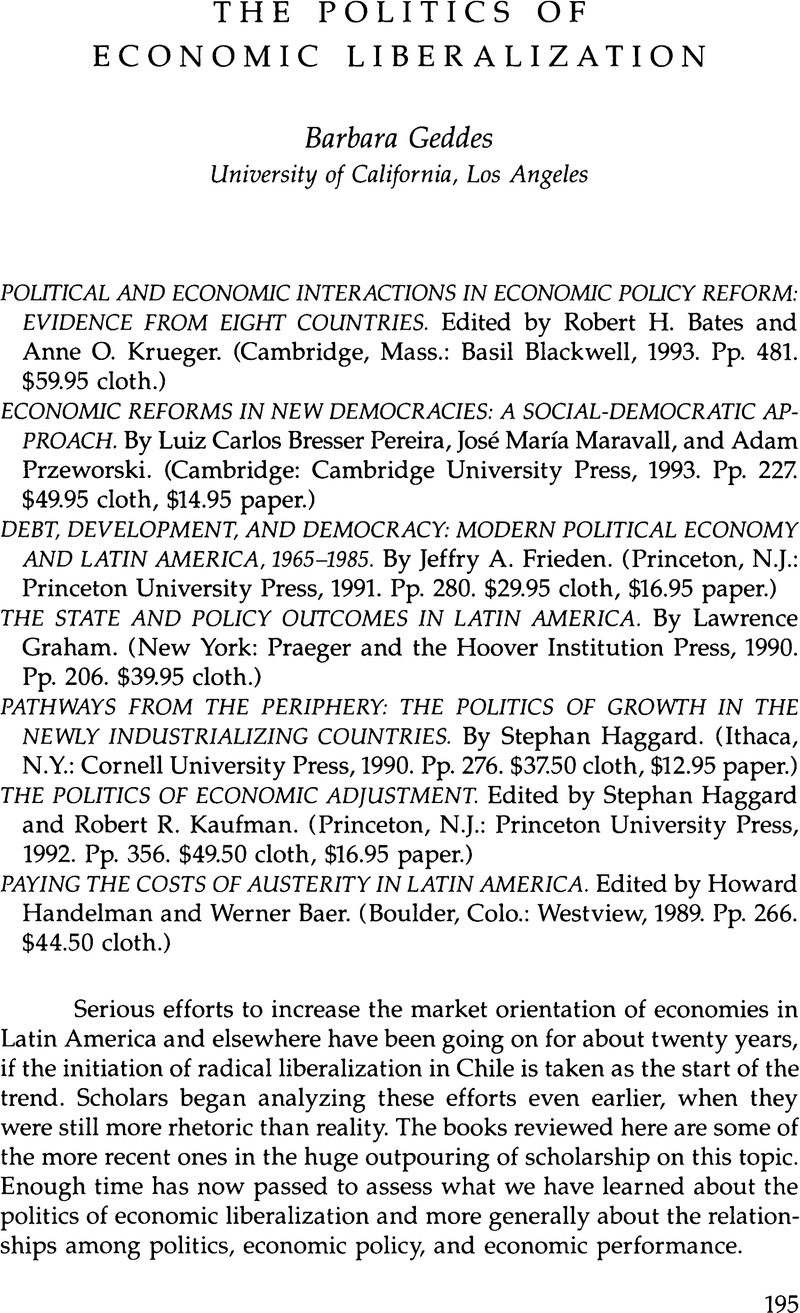Article contents
The Politics of Economic Liberalization
Review products
Published online by Cambridge University Press: 05 October 2022
Abstract

- Type
- Review Essays
- Information
- Copyright
- Copyright © 1995 by the University of Texas Press
References
1. See Karen Remmer, “The Politics of Economic Stabilization: IMF Standby Programs in Latin America, 1954–1984,” Comparative Politics 19, no. 1 (1986):1–24; and “Democracy and Economic Crisis: The Latin American Experience,” World Politics 42 (1990):315–35.
2. Adam Przeworski and Fernando Limongi, “Political Regimes and Economic Growth,” Journal of Economic Perspectives 7 (1993):51–71; and Przeworski and Limongi, “Democracy and Development in South America, 1946–1988,” manuscript.
3. One indication of the strength of the conventional wisdom linking authoritarianism and economic liberalization is that Turkey is mentioned in a number of early studies as an instance of adjustment under authoritarian auspices even though liberalization was begun in early 1980 under a freely elected government, was continued under the same economic team by the military after it seized power later in the same year, and was sustained and deepened throughout the 1980s by the democratic government that came to power in 1983. Liberalization efforts slackened in response to electoral pressures in 1989, although fundamental changes remained in place. Most recently, an elected government announced a dramatic new round of liberalization in early 1994.
4. Barbara Geddes, “How Politicians Decide Who Bears the Cost of Economic Liberalization,” in Transition to a Market Economy at the End of the Twentieth Century, edited by Ivan Berend (Munich: Sudosteuropa-Gesellschaft, 1994); see also Karen Remmer, “The Political Economy of Elections in Latin American, 1980–1991,” American Political Science Review 87 (1993):393–407.
5. See Edward Epstein, “Austerity and Trade Unions in Latin America,” in Lost Promises: Debt, Austerity, and Development in Latin America, edited by William Canak (Boulder, Colo.: Westview, 1989).
6. Official Spanish unemployment figures are usually thought to be overstated by about a quarter. Thus the real Spanish unemployment rate is probably about 15 percent, still very high.
7. Gonzalo Sánchez de Lozado, highly identified with the Paz Estenssoro government and architect of the liberalization plan, won the popular vote by a bare plurality but was denied the presidency by the Bolivian Congress, which decides the outcome of presidential contests in the absence of a majority vote.
8. Glen Biglaiser, “Policy Choices under Military Rule,” paper presented to the Latin American Studies Association, 9–13 Mar. 1994, Atlanta, Georgia.
9. Pérez is not an outsider in the sense of being new to the party but in the sense that because his candidacy was opposed by virtually all established party leaders except labor, he owed no loyalty or debts to the party establishment.
10. This was apparently not true in Poland when the plan proposed by Leszek Balcerowicz was adopted, due no doubt to the dearth of conventionally trained economists in Poland at the time. The only coherent plans put forward for consideration were that of Balcerowicz and another equally orthodox plan (Leszek Balcerowicz, verbal communication, May 1994).
11. For a fuller elaboration of these ideas, see Bates and Krueger and the literature they cite.
- 82
- Cited by




